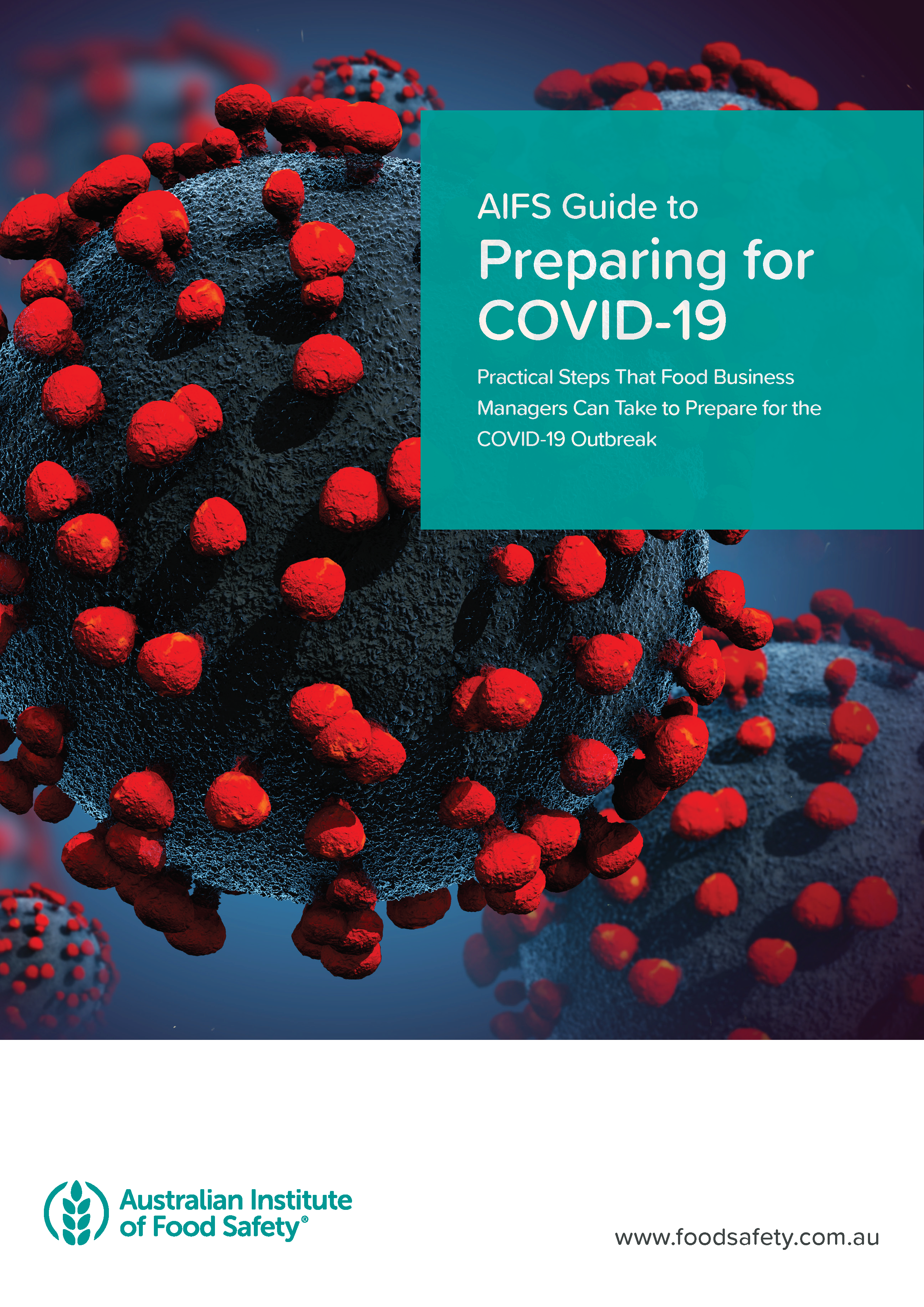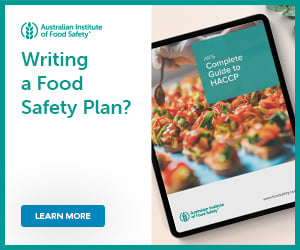
As the COVID-19 outbreak continues to develop around the world, there are practical measures that every food business manager can take to minimise the risk to their employees, customers and business.
This guide covers the four main areas where food businesses can manage risk and provides further details on what practical steps staff should take to protect the business and customers. In using this guide, food businesses will be able to help prevent a COVID-19 outbreak in their business.
As the COVID-19 outbreak continues to develop around the world, there are practical measures that every food business manager can take to minimise the risk to their employees, customers and business.
This guide covers four main areas:
- Increasing Sanitation
- Preparing Your Team
- Helping Your Customers
- Staying Informed
The Australian Institute of Food Safety resource library contains a preparation checklist that can be used in conjunction with this guide to ensure your food business is fully prepared.
Part 1: Increase Your Sanitation
SARS-CoV-2, the coronavirus that causes COVID-19, can live on surfaces for up to nine days. Applying sanitisers is the most effective way of killing the virus.
REVIEW YOUR CLEANING & SANITISING SCHEDULE
A regular cleaning and sanitising schedule for a food business includes instructions for cleaning and sanitising food contact surfaces such as work benches, food preparation equipment and chopping boards.
To ensure the health and safety of your customers during the COVID-19 outbreak, more items than usual need to be sanitised. Anything that is touched often by multiple customers or that is located in a high traffic area needs to be sanitised in order to prevent coronavirus contamination.
Items that may need to be sanitised include:
- Credit card machines
- Chairs and tables
- Menus
- Sauce containers
- Salt and pepper shakers
- Light switches
- Door handles
- Soap dispensers
- Elevator and access buttons
- Railings
- Food trays
Once you have a list of all the items that need to be cleaned and sanitised, update your cleaning and sanitising schedule. Don’t forget to include details of who will perform these tasks and the frequency in which they need to be performed.
CHECK YOUR SANITISERS
Most sanitisers are effective at killing the coronavirus, but it’s important to check with your supplier to confirm that your sanitiser of choice is effective against the SARS-CoV-2 coronavirus.
As you prepare for COVID-19, take the opportunity to confirm that you are:
- using the correct concentration of sanitiser
- applying it at the correct temperature
- applying it for the correct amount of time
Recent research (Kampf 2020) discovered that two commonly used sanitisers that are effective in killing coronaviruses are chlorine (1000ppm) or hydrogen peroxide (0.5%).
CHECK YOUR DISH WASHING MACHINES
Infected customers could transfer the coronavirus onto dishes, glassware or cutlery. Infected employees could transfer the coronavirus onto chopping boards, pots and pans or utensils. You need to be sure that your dish washing machines are effectively sanitising to prevent the spread of the coronavirus onto other items and to your customers.
Commercial dish washing machines use one of two methods to sanitise:
- Hot water
- Chemical sanitiser
If your dish washing machine uses hot water to sanitise, you need to check that the correct temperature is being reached. Most have an built-in thermometer and temperature display, but if you’re unsure how to check, refer to the user manual or contact the manufacturer.
As a general rule, for hot water sanitising the temperature must reach 82°C / 180°F for a minimum of 10 seconds.
If your machine uses a chemical sanitiser, you need to check that the concentration is correct and that the water temperature reaches at least 24°C / 75°F for 20 seconds or longer.
Temperature requirements vary between jurisdictions so always check specific requirements with your local authorities.
STOCK SUPPLIES
During a pandemic, the general public puts a greater emphasis on health and hygiene, both at home and at work. This can mean that:
- your employees and customers use supplies faster than normal
- your regular supplier may have issues meeting demand
Consider building up a stock of supplies to see you through the outbreak, or at a minimum talk to your supplier about lead times so you can be sure not to run out of essential items.
As well as cleaning and sanitising products, consider stocking up on garbage bags, dish wipes, paper towels, toilet paper, hand soap and anything else that may be in high demand during the COVID-19 outbreak.
REVIEW YOUR FOOD SAFETY PROCEDURES
Your Food Safety Plan contains details of all the food safety procedures in your business. Review these procedures and consider what needs to be changed or added during the COVID-19 outbreak.
In this guide, cleaning and sanitising procedures have already been considered in detail, but other common food safety procedures to reconsider include:
EXTRA CHECKS ON DELIVERIES:
- Ensure your suppliers have effective coronavirus control procedures in place.
- Perform thorough checks on all supplies.
- Consider whether you want to discard packaging before bringing items onto your premises.
TEMPERATURE CONTROLS:
- At this stage, the impact of temperature on SARS-CoV-2 is unknown.
- However, ensuring food spends a minimal amount of time in the Temperature Danger Zone ( 4°C - 60°C / 40°F - 140°F) is always a good idea.
EMPLOYEE CLOTHING REQUIREMENTS:
- Stricter requirements about changing into workwear at the workplace minimises the risk of coronavirus being introduced from outside.
- Enforcing workplace-only footwear is also recommended.
- Personal Protective Equipment (PPE) such as disposable gloves, masks and aprons should also be considered if you don’t already use these.
Once you’ve evaluated the changes that you need to make to your Food Safety Plan, document thoroughly and communicate to everyone on your team.
Part 2: Prepare Your Team
Your team is your key defence against the coronavirus. Minimise risk to the business through effective training and communication.
TRAIN YOUR EMPLOYEES
Having well-trained employees is key to ensuring the prevention and control of COVID-19 at your food business. At a minimum, ensure that your employees are trained or re-trained in the following:
- Symptoms of COVID-19
- What to do if they feel sick outside of work
- What to do if they feel sick inside of work
- What to do if an employee or customer gets sick
- Hand washing
- Personal hygiene standards
- Coughing and sneezing etiquette
- Cleaning and sanitising procedures
- General food safety
- Any extra precautions specific to your business
The main symptoms of COVID-19 are:
- High fever
- Cough
- Shortness of breath
Other symptoms may include:
- Nasal congestion
- Runny nose
- Sore throat
- Diarrhoea
In serious cases, COVID-19 can lead to severe pneumonia, organ failure and death. People most at risk of serious symptoms are the elderly and people with other underlying health issues.
COMMUNICATE YOUR SICK LEAVE POLICY
Employees must be told not to attend the workplace if they:
- are experiencing any of COVID-19 symptoms
- live with or have been in close contact with someone who has COVID-19
- believe they may have been exposed to the coronavirus due to attending an event or location linked to a known case
- have recently travelled to a country with a major outbreak of COVID-19
Oftentimes, food workers are nervous of telling managers that they are sick due to the fear of missed pay and lack of shifts.
It’s important to communicate to employees what their entitlements are if they take time off, and what the consequences are if they attend the workplace knowing that they may have been exposed to the coronavirus.
Government authorities around the world are providing financial and other assistance to employers and employees during the COVID-19 outbreak. Check with your local and federal government to learn what assistance may be available for your business.
PUT UP SIGNAGE
Training or re-training all of your employees is a wise move but it’s important to reinforce the message. At a minimum, put signage around the workplace reminding employees about:
- Hand washing technique
- Coughing and sneezing etiquette
- COVID-19 symptoms
Don’t forget to check out the other COVID-19 resources provided in the AIFS resource library.
Part 3: Help Your Customers
Customers will be understandably nervous about eating outside of the home during the COVID-19 outbreak. Putting their minds at ease by showing them the steps you’re taking to prevent the spread of the coronavirus is the best way to ensure continued business during these difficult times.
REASSURE YOUR CUSTOMERS
Some of the ways that you can demonstrate to customers that you take their health and safety seriously include:
- encouraging your employees to perform cleaning and sanitising tasks in front of customers
- encouraging your employees to demonstrate exemplary personal hygiene
- displaying signage about the steps your business is taking to prevent the spread of the coronavirus
- being vocal on social media and your website about the actions you’re taking
ENHANCE YOUR FACILITIES
During outbreaks such as this, customers are more mindful of their health and hygiene. This means that they’ll pay more attention to small details at your business, and they’ll also use more soap, paper towels and other hygiene products.
To ensure the continued protection of your customers during the COVID-19 outbreak:
- Provide tissues and hand sanitiser in multiple locations around your premises.
- Clean and sanitise washrooms more frequently that normal.
- Remove washroom garbage more frequently than normal.
- Ensure that soap, toilet paper and paper towels are fully stocked at all times.
REARRANGE YOUR SEATING
Governments around the world are recommending that people maintain a safe distance of at least 1 metre (3 feet) between each other during the COVID-19 outbreak. Some governments are enforcing this rule in hospitality businesses.
Consider how you can rearrange the seating in your food business to maximise the space between customers. This will help your customers to feel more comfortable about their choice to visit your premises, and will also help to protect them from coronavirus transmission from other people.
Part 4: Stay Informed
Food business managers need to ensure they have the latest information and advice on COVID-19. As scientists around the world research the SARS-CoV-2 virus, more information is becoming available to help food businesses prepare food safely and protect their customers.
CONTACT THE AUTHORITIES
Your local food safety department will be staying up-to-date and informed on all the latest information about COVID-19. Get in touch and ask if there are any steps that they are recommending specifically to your local area.
If you don’t already have a contact in the food safety department, now is a good time to make a connection that you can reach out to if there is a suspected COVID-19 case on your premises.
Ask your food safety contact to keep you informed if there are any changes or new information that you need to know about.
SET UP YOUR INFORMATION SOURCES
There are many sources of information about the COVID-19 outbreak, some more reputable than others.
Find some high-quality sources that contain the type of information you need to run your business (local and state government websites are often best) and then bookmark them online and set a schedule to check them every 1-2 days.
Don’t put too much faith in the information being shared on social media and always consider whether the regular media is publishing a story to sell headlines, rather than to share information in a considerate way.
The Australian Institute of Food Safety will also be publishing regular updates and insights throughout the COVID-19 outbreak.











